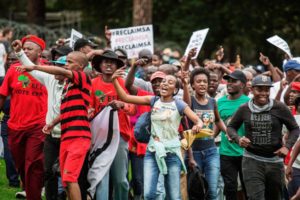

A demonstration against South African President Jacob Zuma on Friday in Pretoria.
GIANLUIGI GUERCIA / AGENCE FRANCE-PRESSE — GETTY IMAGES
By THE EDITORIAL BOARD
APRIL 7, 2017
It’s hard to know what more it will take for the African National Congress, South Africa’s governing party, to curb the outrageous rule of President Jacob Zuma. His corrupt, scandal-riddled leadership over the last eight years has done inestimable damage to his country and to the moral authority of the A.N.C., Nelson Mandela’s party. He was at it again a week ago, in a late-night purge of his government that included the firing of a respected finance minister, Pravin Gordhan, who had sought to rein in the president’s irresponsible spending.
On Friday, tens of thousands of people took to the streets in Cape Town, Durban, Johannesburg and Pretoria in the largest protest in years, to declare that they had had enough of Mr. Zuma. The Save South Africa campaign, a coalition of civil society groups, business leaders and prominent South Africans, declared Mr. Gordhan’s firing “an outrage.” Two rating agencies, Standard & Poor’s and Fitch, downgraded South African government debt to junk status; the rand tumbled by more than 10 percent against the dollar.
And what did the A.N.C. do? In the immediate aftermath of the purge, some of its senior leaders openly criticized the president’s actions. On Wednesday, however, the party, which has dominated post-apartheid South African politics since 1994, did what it always does: It closed ranks behind Mr. Zuma, chided critics for “public dissonance” and vowed that this “will not happen again.”
Gwede Mantashe, the A.N.C. secretary general, who initially acknowledged that worthy ministers had been fired without party approval, now accepted that the firing of Mr. Gordhan was made necessary by an “irretrievable breakdown” of the minister’s relationship with the president. That was evidently shorthand for Mr. Gordhan’s courageous resistance to Mr. Zuma’s spending schemes, including a hugely expensive deal with Russia for nuclear power plants.
The A.N.C. is scheduled to elect a new leader at its conference in December, and that person is likely to become the next president when Mr. Zuma’s second, and final, term ends in 2019. The president would evidently like his successor to be Nkosozana Dlamini-Zuma, who was once his wife and who represents a mostly rural faction of the A.N.C. dependent on his patronage. Pushing Mr. Gordhan out and stuffing the government with cronies will make that easier.
It is clear that Mr. Zuma will continue in his shameless ways as long as he can. The question is whether the A.N.C. is prepared to continue tolerating him as he shrouds South Africa in corruption and destroys the party that once commanded admiration around the world for its moral standing.
Mr. Zuma and his cronies will again claim that they are victims of vindictive Western colonialists. But when tens of thousands of their own countrymen march through the streets, many with “Save South Africa” banners, demanding the president’s ouster, A.N.C. leaders cannot pretend to miss the message.
https://mobile.nytimes.com/2017/04/07/opinion/south-africas-protesters-have-it-right.html?mwrsm=Email&referer=https%3A%2F%2Ft.co%2FCuSvSORy3p

